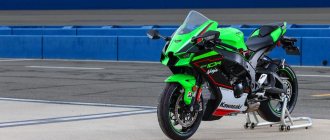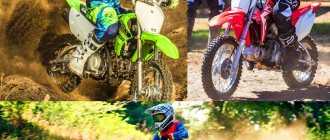Kawasaki ZX-10R 2021
The long-awaited and significantly updated Kawasaki ZX-10R, along with its ultra-sporty brother ZX-10RR, will receive a new design, new LED headlights, hidden aerodynamic wings and a number of other changes that take it to a new level and allow it to successfully compete with the new products of its rivals.
Kawasaki updates
Rumors about updates have been circulating for a long time, especially when early photos from Australia appeared, but the buzz moved into the most active phase when the Kawasaki World Superbike team took part in winter tests of the championship on the 2021 Kawasaki ZX-10RR in racing equipment.
The Kawasaki ZX-10R has been a dominant force in WSBK since 2013 in the hands of Team Kawasaki's top athlete Jonathan Rea. However, recent moves by Ducati and Honda in the form of the Panigale V4R and CBR1000RR-R Fireblade SP have shown that the current (that is, the previous) version of the ZX-10R is losing ground. But if the WSBK winter tests are any indication, Rea's best time suggests that the new ZX-10R will be a worthy counterattack.
Technical specifications and photos of Kawasaki Ninja ZX-10R and ZX-10RR (2021): up to 214 hp. from the box
Kawasaki Motor Europe has presented to the public official photos and technical specifications of the new 2021 Kawasaki ZX-10R and ZX-10RR: power and torque confirmed by the manufacturer!
MOTOGONKI.RU, November 23, 2022 - As previously reported, the official base engine power of the new Ninja ZX-10R will be more than 200 hp, but not much - for the “civilian” version of the motorcycle; however, Kawasaki pulls back the covers and claims 213 hp. when installing a direct intake plastic kit into the airbox without making any modifications to the engine. Peak power is stated at 13,200 rpm.
Kawasaki Ninja ZX-10R (2021)
The ZX-10RR version is only 1 hp. more powerful, but the engine is equipped with more finely machined components with less inertia and, accordingly, greater reliability when operating under extreme conditions. Power will be higher when reaching 800 rpm. higher - by 14,000.
Improved Kawasaki Ninja ZX-10RR Engine Components
Any additional changes to the engine, installing a Race Only exhaust system and installing the appropriate firmware - all this should give an additional increase in power from 5 to 10%.
Lightweight Marchesini wheels on the ZX-10RR
The 2022 Kawasaki Ninja ZX-10RR is a response to the threat to the factory riders' positions in World Superbike from the Ducati Panigale V4R and Honda CBR1000RR-R Fireblade SP, which are built using numerous technologies from MotoGP. Moreover, the Ducati is essentially a slightly reworked prototype of the Desmosedici GP16.
Kawasaki Ninja ZX-10R (2021)
The main changes in the ZX-10R are in the engine and electronics set. Thus, the basic set now includes electronic cruise control, controlled by keys on the left remote control; full color TFT display of the control panel and a full selection of piloting modes.
Kawasaki Ninja ZX-10R (2021)
A separate important feature of the new Kawasaki design is the built-in winglets, or rather, a new style of fairings with integrated air flow breakers that do not protrude much beyond the body and are not “flaps” in the way we are used to seeing in MotoGP.
Kawasaki Ninja ZX-10R Chassis (2021)
The motorcycle chassis is extremely lightweight, new Brembo brakes based on monoblock calipers of the M50 series with 330 mm discs; new version of Showa Balance Free pendants.
Kawasaki Ninja ZX-10R (2021)
Two color options for the Kawasaki ZX-10R are “classic” green and black with green stripes.
Kawasaki Ninja ZX-10RR (2021)
A striking distinctive feature of the Kawasaki ZX-10RR will be the Lime Green color - more poisonous and eye-catching.
Kawasaki Ninja ZX-10R (2021)
Technical specifications of Kawasaki Ninja ZX-10RR (2021)
Engine
Type: in-line, 4-cylinder, 4T, liquid cooled, DOHC, 16 valves. Compression ratio: 13.0:1 Bore and stroke: 76.0 x 55.0 mm Displacement: 998 cc Power system: 4 double injectors, Ø 47 mm Ignition: digital
ZX-10R: Torque: 114.9 Nm at 11400 rpm. Max power: 203 hp at 13200 rpm. Max power with RAM Air: 213 PS at 13200 rpm.
ZX-10RR: Torque: 111.8 Nm at 11800 rpm. Max power: 204 hp at 14000 rpm. Max power with RAM Air: 214 hp at 14000 rpm.
Starter: electric Transmission: 6-speed manual transmission cassette type Lubrication system: forced, in an oil bath with additional cooling Clutch: in an oil bath
Rear wheel drive: chain Primary gear: 1.681 (79/47) Final gear: 2.294 (39/17) Gear ratio 1: 2.600 (39/15) Gear ratio 2: 2.158 (41/19) Gear ratio 3: 1.882 ( 32/17) Gear ratio 4: 1.650 (33/20) Gear ratio 5: 1.476 (31/21) Gear ratio 6: 1.304 (30/23)
Chassis:
Frame: diagonal, aluminum Stem: 105 mm Steering angle: 27° Front wheel free play: 120 mm Rear wheel free play: 115 mm
Brakes: Front: Brembo M50 radial 4-piston monobloc calipers, dual Brembo 330mm semi-floating discs Rear: 1-piston caliper, 220mm disc
Suspension: Front-end: Showa Balance Free Front Fork 43 mm with external compensation reservoir, fully adjustable Rear-end: horizontal shock absorber Showa BFRC Lite (gas-filled) with external compensation reservoir, fully adjustable
Front wheel: 120/70ZR17M/C (58W) Rear wheel: 190/55ZR17M/C (75W) Dimensions (L x W x H): 2085 x 750 x 1185 Wheelbase: 1440 mm Seat height: 835 mm Ground clearance: 135 mm Tank volume: 17 l Curb weight: 207 kg
Kawasaki ZX-10R
Usually the discussion of upgrades starts with the engine, but this time the first thing that catches your eye (literally) is the design. More precisely, the front fairing. Whether you like him or not, one thing is certain - he attracts the eye. Its “sunken” front part gives the rider an excellent view over the slightly elongated windshield, and the new diode headlights are recessed into the fairing so that they do not cause glare when looking at the road. In addition, the updated headlights weigh almost half a kilo less than halogen ones.
The size of the Kawasaki ZX-10R's inertial charge air intake has become smaller, but its efficiency remains the same thanks to a new shape that captures the same volume of air.
Kawasaki ZX-10R
But you won’t see the ubiquitous aerodynamic wings that provide modern sportsbikes with downforce at high speeds on the Kawasaki ZX-10R. And it’s funny, because generally speaking they are there, but they are so cleverly built into the plastic that you can’t see them right away. At the same time, along with the new fairing shape, they provide an increase in downforce by 17%, and drag is reduced by 7%. The side slots in the hood help distribute hot air so that it does not fall on the rider's knees, and the lower part of the plastic neck directs the air flow directly to the new oil cooler, which will be discussed below.
Ergonomics
Ergonomically, the Kawasaki ZX-10R is all about speed and racing: the clip-ons are 10mm further forward and at a more right angle, the footpegs are 5mm higher, helping to shift the rider's weight even further forward, the windshield is 40mm longer and set at a less acute angle, providing improved wind protection, especially when lying on the tank. Finally, the rear seat is raised further than the previous version, raising the rider's rear a little higher for maximum aerodynamic efficiency.
Engine Kawasaki ZX-10R
Now, perhaps, let's move on to the Kawasaki ZX-10R engine. Unlike the already mentioned Honda and Ducati models with their 81mm pistons, the Kawasaki ZX-10R inline four retains a piston diameter of 76mm and a stroke of 55mm. The valves are driven by pusher levers for several reasons - firstly, this scheme is 20% lighter than with glasses, and secondly, it allows for stable operation at higher speeds. The levers have a diamond-like coating on their working surfaces, providing minimal friction with the high-profile camshaft lobes, which are machined (rather than cast) from forged chrome-molybdenum billet. All valves are made of titanium alloy, helping the engine to rotate more easily. It is curious that despite the “aggressive” nature of the cam profiles, the valves return with completely ordinary springs.
A lightweight crankshaft allows the engine to rotate more easily, and cylinders offset relative to the crankshaft axis reduce energy losses due to lateral friction of Teflon-coated pistons at the top.
For those who can't imagine a motorcycle without tuning, the Kawasaki ZX-10R engine head has additional space to install racing camshafts with even longer valve strokes, which, complete with springs, provide even more powerful top end. Previously, this option was only available on the Kawasaki ZX-10RR.
The new oil cooling system no longer uses coolant, instead running oil from the lower left side of the crankcase to the radiator and returning it to the right side.
The Kawasaki ZX-10R meets modern requirements of the Euro 5 environmental standard thanks to an updated titanium exhaust manifold. One of the catalysts is installed closer to the engine, due to which it heats up faster and works more efficiently. The length of the pipe in front of the muffler has become shorter, and the muffler itself has increased by about 12 cm. But since the size of the stock muffler is the main reason for customer complaints (although in this model it would rather be a kind of fairing), Kawasaki engineers selected the length and diameter of the pipe so that the exhaust matched the dimensions of the pure racing version. So replacing the standard can with an aftermarket slip-on will be completely easy.
The previous Kawasaki ZX-10R was known for its extremely long first gear. One of the many track-specific improvements to the new version is a new transmission with shorter first three gears. The 41-tooth rear sprocket is 2 teeth larger than the previous model, combined with shorter gearing for sharper response and powerful acceleration, especially important when exiting corners. And thanks to the KQS quickshifter, the rider can smoothly shift in both directions without pressing the clutch.
Kawasaki ZX-10R chassis
An updated chassis with a fork offset increased by 2mm and a swingarm extended by 8mm helps curb the engine's power. The centimeter difference in wheelbase will provide greater stability, and the reduction in trail will allow the new Kawasaki ZX-10R to lean as easily as before. The swingarm axle is set lower by 1mm, and the new geometry slightly changes the bike's weight distribution, shifting weight forward by 0.2%. Not too much, but the more loaded the front wheel, the better.
Kawasaki ZX-10R chassis
The Showa Balance Free Fork (BFF) may not be as loud as the Ohlins, but technically it is quite impressive. By moving the smoothing valves to the outside of the fork, it was possible to isolate oil pressure fluctuations from the main displacement, and separating the compression and rebound smoothing valves allowed the entire surface of the piston to work, resulting in a softer fork.
The Kawasaki ZX-10R's lower triple clamp has become wider and stiffer, and the fork spring has become slightly softer (21.0 versus 21.5 N/mm), providing improved feedback. The compression smoothing contour, which has become a little stiffer, allows the softer spring to be compensated for, while the rebound contour, on the contrary, has become a little softer. Interestingly, the rear shock absorber (which Showa calls the Balance Free Rear Cushion) received, on the contrary, a stiffer spring (from 91 to 95 N/mm), but softer compression and rebound smoothing contours.
The brakes remain largely the same: 330mm discs with excellent (if outgoing) Brembo M50 calipers and a radial master cylinder. The rear brake received a different brake pad material, and its master cylinder was moved slightly deeper into the motorcycle.
Electronics Kawasaki ZX-10R
Today's superbikes are impossible without electronics, and the Kawasaki ZX-10R is equipped with a set of electronic assistants that is quite standard for this class. Of course, they are based on a five-axis inertia measurement device, which also calculates the sixth axis (yaw).
This is not the first time that an inertia measuring device has been installed on the Kawasaki ZX-10R, as well as predictive (rather than reactive) traction control, i.e. predicting the need for intervention rather than tracking differences in wheel speed. But it is worth mentioning that the system scans the situation with a resolution of 5 milliseconds, and traction control intervenes by changing the ignition timing, and only if such intervention is insufficient, it closes the gas. The system has 6 stages, from first to fifth and “off”. What's funny is that the 4th and 5th stages (the ones with the most intervention) have been modified to allow throttle input while cornering without affecting the chassis. In addition, the system is smart enough to distinguish between intentional and accidental power wheelies.
Riding Modes Kawasaki ZX-10R
And there are as many as 7 riding modes on the Kawasaki ZX-10R: three standard (Sport, Road, Rain) and four customizable ones, in which the rider sets the level of power, traction control and other parameters to taste. Modes can be changed on the fly using the left remote control. Other electronic aids include launch control, engine braking control, and cornering control, which uses ABS (KIBS) and traction control algorithms to monitor and regulate lean brake pressure to prevent the motorcycle from flattening out during cornering. trail breaking.
For the first time, the Kawasaki ZX-10R is equipped with cruise control thanks to fully electronic throttle, i.e. throttle position sensor and digitally controlled throttle valves.
And finally, another nice change - the Kawasaki ZX-10R's instrument panel has been significantly updated. As such, the motorcycle is equipped with a full-color TFT panel that displays the operating parameters of the motorcycle in an easy to read form. The panel can operate in two modes, one of which is designed for road driving, and the second for track driving.
The new dashboard has a built-in Bluetooth chip that allows you to connect a smartphone with the Rideology app installed to the motorcycle. Given the racing nature of the 10R, the app's most enjoyable feature is the detailed ride log, which details speed, engine rpm, gear, throttle position, front brake pressure, acceleration/deceleration, mileage and even coolant temperature. Kawasaki doesn't market this feature as a track telemetry option, but it can certainly be used as such.
Kawasaki ZX-10RR
Kawasaki ZX-10RR
The Kawasaki ZX-10RR is an even more track-oriented model, much like the ZX-10R. The main differences are in the engine. For starters, its redline is 400 rpm higher, which allows you to hold the gear a little longer, avoiding shifting.
Increasing the cut-off speed is made possible thanks to titanium connecting rods and lightweight pistons from the racing brand Pankl. Thanks to each connecting rod being 102 grams lighter, the RR's moment of inertia is 5% lower than the R's - and it feels like a livelier, freer-turning engine. Further, the RR pistons have one fewer ring, making them 33.7mm shorter in height, which reduces energy loss due to friction. Due to the Kawasaki ZX-10RR's track-oriented design, the double-height intake funnels used on the ZX-10R have been abandoned. While the ZX-10R's hoppers are 10-30-30-10mm high for improved mid-range power, the RR's are all 5mm high for maximum top-end power.
In addition, the Kawasaki ZX-10RR is equipped with a more aggressive camshaft, delivering more power at the top end, likely due to increased valve lift compared to the R. This hypothesis is supported by the fact that the RR is equipped with milled valve heads, which have a higher precision, which is important for reliable operation at high speeds.
The Kawasaki ZX-10RR is equipped with the same Showa BFF and BFRC suspension as the standard R model, with the difference that the base adjuster settings have been changed to accommodate another important difference - lightweight forged aluminum seven-spoke wheels from Marchesini.
Kawasaki Ninja ZX10R 2022 sportbike introduced
The Japanese continue to roll out their new products and today it’s Kawasaki’s turn. The green stable presented several updated versions of its top-end sport bike, the Kawasaki Ninja ZX10R 2022.
The first thing that's immediately obvious is the new design, which is unlikely to be appreciated by boys with bare ankles, but the race track is not a beauty contest, at least not around the world.
Everyone was expecting the new 2022 Ninja ZX10R to feature winglets like all its competitors, but Kawasaki engineers went a different route and integrated them right into the fairing in front of the headlights.
Judging by the data presented, this solution had the desired effect and creates 17% more downforce than the current generation of the “tens”. The windscreen is 40mm higher and the footpegs are raised 5mm, making the ergonomics more extreme.
The chassis has also undergone changes: the swingarm has become 8 mm longer, its mounting point is now 1 mm lower (adjustable on the limited “RR” version), the fork offset angle has been changed by 2 mm, which together has led to an increase in the wheelbase to 1450 mm ( by 10 mm). It’s nice that the stock Kawasaki Ninja ZX10R 2021 is equipped with an Öhlins electronic damper, which will greatly simplify life for absolutely everyone.
The gear ratios have also changed, 1st, 2nd, and 3rd gears have become shorter, in order to better realize 200+ hp. at low and medium speeds, but the inline 998 cc four remained unchanged, except that the cooling radiator was modified to make life easier for the heat-loaded engine.
The motorcycle also received a new 4.3″ TFT dashboard, which does everything the same as any other modern one. In addition, the ZX10R is equipped with cruise control to match its competitors, and even heated grips, apparently so that Jonathan Ray does not freeze his fingers during off-season testing.
In terms of electronics, which are really necessary for a modern superbike, everything is on par with the others - a 6-axis Bosch unit with corner ABS and all kinds of launch, traction, wheelie and other controls.
The 2022 Kawasaki Ninja ZX10R and ZX10R KRT, featuring only Kawasaki's factory WSBK team colors, will go on sale in May '21 and will cost $16,700 and $17,400 in the US respectively, which is cheaper than both the Honda Fireblade and Yamaha R1.
But the limited-edition Kawasaki Ninja ZX10RR (500 units), made only on the basis of homologation requirements for the Superbike World Championship, will cost as much as $28,999 and will feature a “shifted” cutoff from 14,300 rpm to 14,700 rpm, lightweight connecting rods and Pankl pistons and forged aluminum Marchesini wheels.
Tags
2021 Kawasaki New news Sportbike











